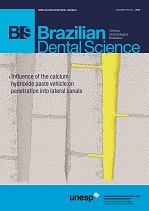Comparison between open and closed-tray impression techniques on the implant transfer accuracy
DOI:
https://doi.org/10.14295/bds.2018.v21i3.1568Resumo
Objective: This in vitro study aimed to determine and compare the dimensional accuracy of open and closed-tray impression techniques for implant-supported prosthesis. Material and Methods: On a edentulous master model, four external hexagonal implants were parallelly installed and associated with four multi unit coping transfers and four multi unit rotational caps. A master superstructure was constructed and splinted all implants (control group). Five customized trays were constructed to perform ten open (n=5) and closed-tray (n=5) impressions. The obtained models were submitted to the dimensional analysis on three points in the center of the labial face of each implant (A, B, C, and D) with the aid of Stereoscopic Magnifying Glass with x60 magnification. The vertical misfit between the metallic structure and the implant analogues was measured on each point. The obtained results were submitted to Dixon’s normality test and Kruskal-Wallis test for independent samples (p < 0,05) with the aid of Bioestat 5.0 software. Results: The means and standard deviation were: open tray technique – 24.6474 ± 14.8883 µm; closed-tray technique – 26.2257 ± 9.7421 µm; and control group 22.445 ± 7.7106 µm. Conclusion: The accuracy of open and closed-tray impression techniques showed no statistically significant differences and both techniques were effective for implant transfer.
Downloads
Downloads
Arquivos adicionais
Publicado
Como Citar
Edição
Seção
Licença
TRANSFERÊNCIA DE DIREITOS AUTORAIS E DECLARAÇÃO DE RESPONSABILIDADE
Toda a propriedade de direitos autorais do artigo "____________________________________________________________________" é transferido do autor(es) para a CIÊNCIA ODONTOLÓGICA BRASILEIRA, no caso do trabalho ser publicado. O artigo não foi publicado em outro lugar e não foi submetido simultaneamente para publicação em outra revista.
Vimos por meio deste, atestar que trabalho é original e não apresenta dados manipulados, fraude ou plágio. Fizemos contribuição científica significativa para o estudo e estamos cientes dos dados apresentados e de acordo com a versão final do artigo. Assumimos total responsabilidade pelos aspectos éticos do estudo.
Este texto deve ser impresso e assinado por todos os autores. A versão digitalizada deverá ser apresentada como arquivo suplementar durante o processo de submissão.




























